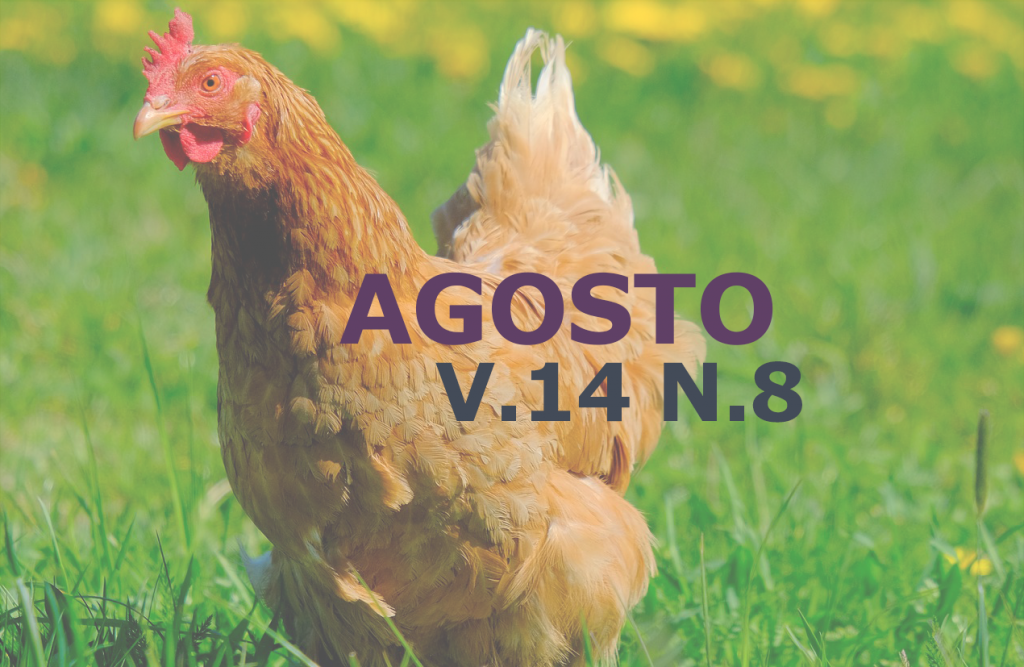Gastrointestinal parasites in a semi-intensive rearing of free-range chickens, in the municipality of Carmo do Paranaíba, Minas Gerais
DOI:
https://doi.org/10.31533/pubvet.v14n8a623.1-10Keywords:
poultry, endoparasitoses, broiler chicken, nematodesAbstract
Free-range chicken raised under extensive and semi-intensive systems has access to outside areas for grazing and exercise practices, which allows greater environmental exposure to infectious agents. The goal of the present study was to determine the presence of gastrointestinal parasites in a free-range chicken farm in the municipality of Carmo do Paranaíba, MG, in addition to establishing the possible risk factors. The study was carried out in a breeding of 1800 free-range chickens (Gallus gallus domesticus), bred under the semi-intensive production system, housed in eight sheds, separated by breeding phase according to age (Phases: Pre-initial 1 and 2- compound by birds of five to 10 weeks, Initial 1 and 2- 10 to 16 weeks and Slaughter 1 and 2- 16 to 20 weeks). The sample was based on the expected average occurrence of 55.4%, according to a previous study, totaling 268 samples, about 45 samples / box. The determination of the occurrence of parasites was carried out by collecting excreta in a cardboard positioned under the perch and the birds were expected to defecate and about 10 grams of the upper part of the excreta were collected, with subsequent evaluation by qualitative (Willis and Hoffman) and quantitative methods (n eggs/blade). Risk factors were assessed using an epidemiological questionnaire, with selection of the variables: age, type of feeding, disposal and periodic change of flock litter, control of entry and exit of birds in the flocks, deworming and vaccination. A non-parametric Odds Ratio test was used for two independent samples, with a significance level of 5% for the analysis of risk factors. The determined occurrence was 57.46% (154/268) and differed between the breeding phases in the semi-intensive system. The slaughter phase showed a lower frequency of eggs (46.06%) compared to the initial phases (Pre-initial 61.79% and Initial 64.44%) (P <0.001). Eggs of the genera Ascaridia spp. and Synganus trachea. Thus, it was concluded that free-range chickens belonging to a rural property in Carmo do Paranaíba, MG had nematodes, the initial phases being more parasitized, thus giving rise to studies aimed at applying better sanitary hygiene management practices in this type of breeding.
Downloads
Published
Issue
Section
License
Copyright (c) 2020 Belchior De Oliveira Santana Neto, Nadia Grandi Bombonato, Andresa dos Santos Veras, Renata Lima de Miranda, Jacqueline Ribeiro de Castro

This work is licensed under a Creative Commons Attribution 4.0 International License.
Você tem o direito de:
Compartilhar — copiar e redistribuir o material em qualquer suporte ou formato
Adaptar — remixar, transformar, e criar a partir do material para qualquer fim, mesmo que comercial.
O licenciante não pode revogar estes direitos desde que você respeite os termos da licença. De acordo com os termos seguintes:
Atribuição
— Você deve dar o crédito apropriado, prover um link para a licença e indicar se mudanças foram feitas. Você deve fazê-lo em qualquer circunstância razoável, mas de nenhuma maneira que sugira que o licenciante apoia você ou o seu uso. Sem restrições adicionais
— Você não pode aplicar termos jurídicos ou medidas de caráter tecnológico que restrinjam legalmente outros de fazerem algo que a licença permita.





